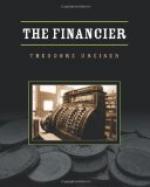The rooms, which were now slowly being decorated and furnished in period styles were very significant in that they enlarged and strengthened Frank Cowperwood’s idea of the world of art in general. It was an enlightening and agreeable experience—one which made for artistic and intellectual growth—to hear Ellsworth explain at length the styles and types of architecture and furniture, the nature of woods and ornaments employed, the qualities and peculiarities of hangings, draperies, furniture panels, and door coverings. Ellsworth was a student of decoration as well as of architecture, and interested in the artistic taste of the American people, which he fancied would some day have a splendid outcome. He was wearied to death of the prevalent Romanesque composite combinations of country and suburban villa. The time was ripe for something new. He scarcely knew what it would be; but this that he had designed for Cowperwood and his father was at least different, as he said, while at the same time being reserved, simple, and pleasing. It was in marked contrast to the rest of the architecture of the street. Cowperwood’s dining-room, reception-room, conservatory, and butler’s pantry he had put on the first floor, together with the general entry-hall, staircase, and coat-room under the stairs. For the second floor he had reserved the library, general living-room, parlor, and a small office for Cowperwood, together with a boudoir for Lillian, connected with a dressing-room and bath.
On the third floor, neatly divided and accommodated with baths and dressing-rooms, were the nursery, the servants’ quarters, and several guest-chambers.
Ellsworth showed Cowperwood books of designs containing furniture, hangings, etageres, cabinets, pedestals, and some exquisite piano forms. He discussed woods with him—rosewood, mahogany, walnut, English oak, bird’s-eye maple, and the manufactured effects such as ormolu, marquetry, and Boule, or buhl. He explained the latter—how difficult it was to produce, how unsuitable it was in some respects for this climate, the brass and tortoise-shell inlay coming to swell with the heat or damp, and so bulging or breaking. He told of the difficulties and disadvantages of certain finishes, but finally recommended ormolu furniture for the reception room, medallion tapestry for the parlor, French renaissance for the dining-room and library, and bird’s-eye maple (dyed blue in one instance, and left its natural color in another) and a rather lightly constructed and daintily carved walnut for the other rooms. The hangings, wall-paper, and floor coverings were to harmonize—not match—and the piano and music-cabinet for the parlor, as well as the etagere, cabinets, and pedestals for the reception-rooms, were to be of buhl or marquetry, if Frank cared to stand the expense.




